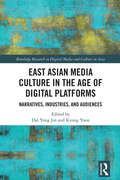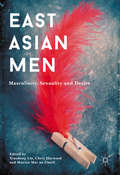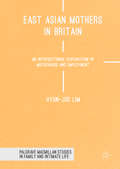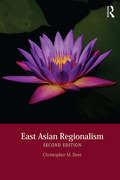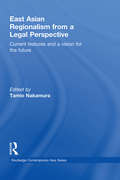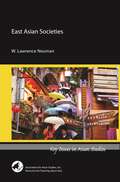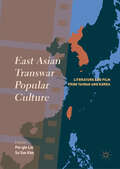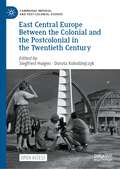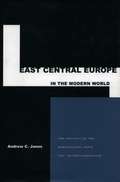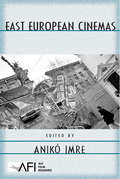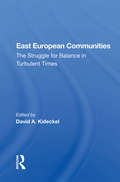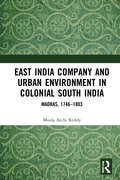- Table View
- List View
East Asian Law: Universal Norms and Local Cultures
by Lucie Cheng Arthur Rosett Margaret Y.K. WooThis work explores the tension in East Asia between the trend towards a convergence of legal practices in the direction of a universal model and a reassertion of local cultural practices. The trend towards convergence arises in part from 'globalisation', from 'rule of law programs' promulgated by institutions such as the International Monetary Fund and the Asian Development Bank, and from widespread migration in the region, whilst the opposing trend arises in part from moves to resist such 'globalisation'. This book explores a wide range of issues related to this key problem, covering China in particular, where resolving differences in conceptions about the rule of law is a key issue as China begins to integrate itself into the World Trade Organisation regime.
East Asian Low-Carbon Community: Realizing a Sustainable Decarbonized Society from Technology and Social Systems
by Ken’ichi Nakagami Weisheng Zhou Xuepeng QianThis book presents new vision of regional de-carbonization with concrete scheme design and substantial quantitative demonstration from original interdisciplinary studies. It provides new horizon for not only climate change, environmental conservation but also for international cooperation and peace in East Asia. The chapters introduce diverse low carbon society principles from local to global level with best practices integrating technology evolution and social innovation. While the book is designated for academics and the ultimate goal is to facilitate international climate regime making and environmental cooperation, local government and international organizations (United Nations, World Bank, and others) officers, researchers, international NGO/NPOs, consultants, students (particularly those studying environmental policy studies or international relationships), as well as reporters will find this book useful in broadening their understanding of low-carbon development in East Asia.
East Asian Media Culture in the Age of Digital Platforms: Narratives, Industries, and Audiences (Routledge Research in Digital Media and Culture in Asia)
by Dal Yong Jin Kyong YoonFocusing on the convergence of popular culture and digital platforms in the East Asian context, this book delves into the increasing role of East Asia, not only as the largest cultural market but also as one of the most rapidly developing cultural industries in the global platform economy.Through the analytical framework of the platformization of cultural industries, this volume theoretically and empirically explores how East Asian popular culture and digital platforms have been intertwined and evolved. Analyzing how East Asian media narratives, industries, and audiences are integrated into digital platformization, the book contributes to an enhanced and timely understanding of transnational cultural flows in platform-driven media landscapes of the early 21st century.The comprehensive and significant analyses of the dynamic changes and persistent features of East Asian cultural convergence within the broader ebb and flow of global modernity will make this book an ideal selection for students and researchers of media studies, cultural studies, digital media, Korean studies, Chinese Studies, Japanese studies, East Asian studies, sociology, anthropology, and globalization studies.
East Asian Men: Masculinity, Sexuality and Desire
by Xiaodong Lin, Chris Haywood and Mairtin Mac an GhaillThis book provides a fresh and contemporary take on the study of men and masculinity. It highlights new and exciting approaches to sexuality, desire, men and masculinity in East Asian contexts, focusing on the interconnections between them. In doing so, it re-examines the key concepts that underpin studies of masculinity, such as homophobia, homosociality and heteronormativity. Developing new ways of thinking about masculinity in local contexts, it fills a significant lacuna in contemporary scholarship. This thought-provoking work will appeal to students and scholars of gender studies, cultural studies and the wider social sciences.
East Asian Mothers in Britain: An Intersectional Exploration Of Motherhood And Employment (Palgrave Macmillan Studies in Family and Intimate Life)
by Hyun-Joo LimHow do Chinese, Japanese and Korean mothers in Britain make sense of their motherhood and employment? What are the intersecting factors that shape these women’s identities, experiences and stories? Contributing further to the continuing discourse and development of intersectionality, this book examines East Asian migrant women’s stories of motherhood, employment and gender relations by deploying interlocking categories that go beyond the meta axes of race, gender and class, including factors such as husbands’ ethnicities and the locality of their settlement. Through this, Lim argues for more detailed and context specific analytical categories of intersectionality, enabling a more nuanced understanding of migrant women’s stories and identities. East Asian Mothers in Britain will appeal to students and scholars across a range of disciplines and with an interest in identity, gender, ethnicity, class, migration and intersectionality.
East Asian Pop Culture
by Chua Beng HuatThe International group of contributors of this volume provides, collectively, a multi-layered analysis of the emerging East Asian media culture, using the Korean TV drama as its analytic vehicle. By closely examining the political economy of TV industry, audiences of the regional media flows in terms of gender subjectivity constructions, perceptions of colonial-postcolonial relationships, and nationalist responses to trans-national media culture exchanges, this volume highlights the multiple connectivities and implications of popular cultural flows and exchanges in East Asia.
East Asian Regionalism
by Christopher M. DentEast Asia is one of the world's most dynamic and diverse regions and is also becoming an increasingly coherent region through the inter-play of various integrative economic, political and socio-cultural processes. Fully updated and revised throughout, this new edition explores the various ways in which East Asian regionalism continues to deepen. The second edition has been expanded to incorporate coverage of significant issues that have emerged in recent years including: Growing tensions in the region over maritime territory and historical issues Competing regional free trade agreement negotiations The impact of the global financial crisis on financial co-operation and engagement with global governance Obama’s ‘pivot to Asia’ and developments in US relations with East Asia The influence of new technology and social media on micro-level regional relations The growing importance of ‘new diplomacy’ issues such as energy security, climate change, food security and international migration. Key pedagogical features include: end of chapter 'study questions' case studies that discuss topical issues with study questions also provided useful tables and figures which illustrate key regional trends in East Asia Extensive summary conclusions covering the chapter's main findings from different international political economy perspectives. East Asian Regionalism is an essential text for courses on East Asian regionalism, Asian politics and Asian economics.
East Asian Regionalism from a Legal Perspective: Current features and a vision for the future (Routledge Contemporary Asia Series)
by Tamio NakamuraPlenty has been written about the political and economical aspects of regionalism, but the legal perspective has been neglected. East Asian Regionalism From a Legal Perspective is unique in synthesizing legal, economic and political analyses. In the first part, the book investigates the current features of regionalism from a comparative perspective, looking at economic and currency cooperation and comparing Asian regionalism with Europe and Latin America. In the second part, the contributors go on to look at the present legal features of regionalism, covering institutional frameworks, trade diversity and regional integration. The third part of the book is truly unique in proposing an essential groundwork for the institutionalisation of an East Asian Community. It conceives a draft East Asian Charter, an essential document that distils what East Asian nations have achieved, and also includes integral principles and fundamental rules for future cooperation among countries and peoples in the region. This book will be of interest to graduates and academics interested in regionalism, international relations, international law and Asian studies.
East Asian Security in the Post-Cold War Era
by Sheldon W. SimonThis edition adds chapters on Burma and Vietnam, and updated material throughout reflects the current economic crisis in the region.
East Asian Social Movements
by Jeffrey Broadbent Vicky BrockmanIn the study of civil society and social movements, most cases are based in Western Europe and North America. These two areas of the world have similar histories and political ideals and structures in common which in turn, affect the structure of its civil society. In studying civil society in Asia, a different understanding of history, politics, and society is needed. The region's long traditions of centralized, authoritarian states buttressed by Confucian and in some cases Communist ideologies may render this concept irrelevant. The chapters in this international volume cover most of the areas and countries traditionally defined as belonging to East Asia: Japan, Taiwan, South Korea, Hong Kong, Singapore and China. The case studies included in this volume confront the utility of using the Western concept of civil society, represented in its most active form - social movements - to think about East Asia popular politics. Along with providing an array of important case studies of social movements in East Asia, the introduction, chapters and conclusion in the book take up three major theoretical questions: the effect of the East Asian cultural, social and institutional context upon the mobilization, activities and outcomes of social movements in that region, the role of social movements in larger transformative processes, utility of Western social movement concepts in explaining social movements in East Asia. This book will be of interest to two major groups of readers, those who study East Asia and those who pursue social movements and civil society, as well as politics more generally.
East Asian Societies
by W. Lawrence NeumanSo very many teach introductions to East Asia under different disciplines, including the Humanities, Sociology, Economics, History, and Religious Studies, but what makes this work so promising is its transferability across these lines of demarcation for the student engaged in her first serious study of the region. Neuman’s fine overview addresses the recurring cultural tasks across East Asia from family, to school and work, and socio-economic stratifications. Neuman has written an ideal introductory text with a sociologist’s clarity, a humanist’s learning, a researcher’s sharp eye, and a teacher’s fine sense of proportion. This is the only intellectual guidebook you will need to take with you for your voyage to East Asia.
East Asian Transformation: On the Political Economy of Dynamism, Governance and Crisis (International Political Economy Ser.)
by Jeffrey HendersonFrom the re-emergence of Japan as an industrial power in the 1950s through to the contemporary rise of China as a potential economic and political behemoth, the story of East Asian development has been central to any serious analysis of the dynamics and trajectory of the global political economy. Integrated into a coherent, critical narrative, this book examines key political-economic and social dynamics that helped forge the ‘miracle’ economies of East Asia and continue to drive them forward in the volatile circumstances of our current epoch. It analyses the relation between the state and markets; the changing nature of economic governance and its relation to inequality; and the rise of China and its international consequences. Historically informed and comparative in nature, the book contributes to the analysis of the transformations of Japan, Hong Kong, South Korea, Taiwan, Singapore, Malaysia and China, and is the first to cover the ground in one volume. Written by a leading analyst of East Asian development, the book engages with the relevant issues and debates, in an open, non-technical language, making it useful as an advanced textbook not only for East Asian studies, but more generally in international political economy and development studies.
East Asian Transwar Popular Culture: Literature and Film from Taiwan and Korea
by Pei-Yin Lin Su Yun KimThis collection examines literature and film studies from the late colonial and early postcolonial periods in Taiwan and Korea, and highlights the similarities and differences of Taiwanese and Korean popular culture by focusing on the representation of gender, genre, state regulation, and spectatorship. Calling for the “de-colonializing” and “de–Cold Warring” of the two ex-colonies and anticommunist allies, the book places Taiwan and Korea side by side in a “trans-war” frame. Considering Taiwan–Korea relations along a new trans-war axis, the book focuses on the continuities between the late colonial period’s Asia-Pacific War and the consequent Korean War and the ongoing conflict between the two sides of the Taiwan Strait, facilitated by Cold War power struggles. The collection also invites a meaningful transcolonial reconsideration of East Asian cultural and literary flows, beyond the conventional colonizer/colonized dichotomy and ideological antagonism.
East Central Europe Between the Colonial and the Postcolonial in the Twentieth Century (Cambridge Imperial and Post-Colonial Studies)
by Siegfried Huigen Dorota KołodziejczykThis open access book explores the ambiguity of East Central Europe during the twentieth century, examining local contexts through a comparative and transnational reworking of theoretical models in postcolonial studies. Since the early modern period, East Central Europe has arguably been an object of imperialism. However, at the same time East Central European states have been seen to be colonial actors, with individuals from the region often associating themselves with colonial discourses in extra-European contexts. Spanning a broad time period until after the Second World War and covering the governance of Communism and its legacies, the book examines how cultural and literary narratives from East Central Europe have created and revised historical knowledge, making use of collective memory to feed into identity models.
East Central Europe and the Former Soviet Union: Environment and Society
by David TurnockSince 1898, the former communist countries of Eastern Europe have gained international prominence. The continuing socio-economic transition and the instability evident in areas like the Caucasus and Former Yugoslavia have drawn the western world into uneasy interactions with the region. At the same time, closer commercial and cultural contacts are providing opportunities for rewarding relationships which have now resulted in many of these countries joining the EU.This book provides detailed coverage of the transition from communism to a market economy. Covering the whole range of East Central European and former Soviet Union countries, it charts the diversity within the region, offering in-depth coverage of specific areas as well as a broad view of development across the region. The book is organised into three comprehensive sections: the historical, socio-economic and environmental. The socio-economic section considers the critical issues of restructuring to effect the transition from central planning to a market economy, while the historical material provides an essential context for the constraints and opportunities affecting the region. The environmental section places emphasis on results of environmental neglect inherited from communism as well as looking to the future implications of EU directives on the problems of biodiversity and pollution in the region.
East Central Europe in the Modern World: The Politics of the Borderlands from Pre- to Post-Communism
by Andrew C. JanosThrough changes from western liberalism to corrupted parliamentarianism, from fascism to state socialism, and now to capitalist democracy, Janos (political science, U. of California- Berkeley) finds a persistence of challenges in the region's economic backwardness compared with the West, the debilities of small nationhood, and the cultural divide between lands of eastern and western Christianity. He seeks a balance between cultural and economic explanations of conflict, between structural and institutional approaches to politics, and between forces inside and outside society as shapers of power and politics in the states. Annotation c. Book News, Inc., Portland, OR (booknews.com)
East Eats West: Writing in Two Hemispheres
by Andrew LamFrom cuisine and martial arts to sex and self-esteem, East Eats West shines new light on the bridges and crossroads where two hemispheres meld into one worldwide “immigrant nation.” In this new nation, with its amalgamation of divergent ideas, tastes, and styles, today's bold fusion becomes tomorrow's classic. But while the space between East and West continues to shrink in this age of globalization, some cultural gaps remain. In this collection of twenty-one personal essays, Andrew Lam, the award-winning author of Perfume Dreams, continues to explore the Vietnamese diaspora, this time concentrating not only on how the East and West have changed but how they are changing each other. Lively and engaging, East Eats West searches for meaning in nebulous territory charted by very few. Part memoir, part meditation, and part cultural anthropology, East Eats West is about thriving in the West with one foot still in the East.
East Eats West: Writing in Two Hemispheres
by Andrew Lam“Includes some of Lam’s most memorable writings, about cuisine, self-esteem, sex and kung fu, all seen from a two-hemisphere perspective.” —SFGate East Eats West shines new light on the bridges and crossroads where two global regions meld into one worldwide “immigrant nation.” In this new nation, with its amalgamation of divergent ideas, tastes, and styles, today’s bold fusion becomes tomorrow’s classic. But while the space between East and West continues to shrink in this age of globalization, some cultural gaps remain. In this collection of twenty-one personal essays, Andrew Lam, the award-winning author of Perfume Dreams, continues to explore the Vietnamese diaspora, this time concentrating not only on how the East and West have changed but how they are changing each other. Lively and engaging, East Eats West searches for meaning in nebulous territory charted by very few. Part memoir, part meditation, and part cultural anthropology, East Eats West is about thriving in the West with one foot still in the East.“In these lovely, wise, probing essays, Andrew Lam not only illuminates the crucial twenty-first-century issues of immigration and cultural identity but the greater, enduring issues of what it means to be human . . . a compelling book.” —Robert Olen Butler, Pulitzer Prize–winning author “Andrew Lam is an expert time-traveler, collapsing childhood and adulthood; years of war and peace; and the evolution of language in his own life, time, and mind. To read Andrew’s work is a joy and a profound journey.” —Farai Chideya, author of The Episodic Career“One of the best American essayists of his generation.” —Wayne Karlin, author of A Wolf by the Ears
East End Underworld: Chapters in the Life of Arthur Harding (Routledge Revivals: History Workshop Series)
by Raphael SamuelFirst published in 1981, this book examines the life of Arthur Harding, a well-known figure in the East End underworld during the first half of the twentieth century. The first five chapters survey his life in the ‘Jago’ slum between 1887 and 1896, offering a different view of an often vilified district. The subsequent phases of his life as a cabinet-maker, street trader and wardrobe dealer reflect the changing fortunes of the East End from hand-to-mouth conditions in the late-nineteenth century to comparative security in the 1930s. The reader is introduced to some of the major features of East End life — back-street enterprise, neighbourhood solidarity, politics and popular culture. Among the many themes that can be traced are the relationship between the underworld and the local working-class community; the collusive understanding established between villains and the police; the effects of the criminalisation of street betting; and the relationship between Jews, non-Jews and what the author terms ‘half-jews’ in a district of high immigration. Drawn from transcripts of recorded reminiscences, this book provides an important text for understanding the political economy of crime — extended by the authors extensive footnotes and a preface discussing the peculiar moral complexion of south-west Bethnal Green.
East European Cinemas (AFI Film Readers)
by Anikó ImreFirst Published in 2005. Routledge is an imprint of Taylor & Francis, an informa company.
East European Communities: The Struggle For Balance In Turbulent Times
by David A. KideckelThis book focuses on communities in the east European transition and the diverse issues which people face in them on a daily basis. It is organized around three themes: economic change and privatization; the transformation of social and political organization; and changing community belief system.
East European Diasporas, Migration and Cosmopolitanism (BASEES/Routledge Series on Russian and East European Studies)
by Ulrike Ziemer Sean P. RobertsFollowing the demise of the USSR in 1991, and the ensuing collapse of communist regimes in Eastern Europe, widespread population movements took place across Central and Eastern Europe. Whole nations disappeared and (re)-emerged and diasporic transnational ties and belonging have experienced a revival. This book explores some of the many different facets of diasporic life and migration across Central and Eastern Europe by specifically employing the concept of cosmopolitanism. It examines aspects of migrants’ everyday lives and identities, considers some of the difficulties faced by migrant minorities in being accepted and integrated in the host societies, but also examines questions of citizenship and diasporic politics.
East India Company , The: A History (Studies In Modern History)
by Philip LawsonThis is the first short history of the East India Company from its founding in 1600 to its demise in 1857, designed for students and academics. The Company was central to the growth of the British Empire in India, to the development of overseas trade, and to the rise of shareholder capitalism, so this survey will be essential reading for imperial and economic historians and historians of Asia alike. It stresses the neglected early years of the Company, and its intimate relationship with (and impact upon) the domestic British scene.
East India Company and Urban Environment in Colonial South India: Madras, 1746–1803
by Moola Atchi ReddyThis book makes a pioneering attempt to analyse the linkages between the rule of East India Company and urban environment in colonial India over more than a half-century - from 1746 to 1803 - through a study of the city of Madras (present Chennai). The book traces urban development in colonial South India from a broad economic history point of view and with a focus on its environmental dimension, covering the period from the First Carnatic War until the 18th century by which time the English East India Company had consolidated its power. It discusses themes such as urban development; infrastructural development; housing and buildings, city and suburbs; and development of land and roads in the colonial period. Using extensive archival resources, it offers new insights on the various aspects of the shifting urban physical environment and captures the development of Madras city limits; road infrastructure, building of paved streets, whitewashed walls and compounded houses; establishment of garden houses; use of land resources; development of masonry bridges by merchants; housing problems; and the building of Fort House, Garden House, Admiralty House, Pantheon House, Custom House, etc. in Madras, to describe the impact of colonialism on urban environment. An important contribution to the history of urban economics and environment, this book with its lucid style and rich illustrations will be an essential read for scholars and researchers of colonial history, modern Indian history, environmental history, urban environment, urban history, political economy, urban economic history, Indian history, and South Asian studies.
East Indians in a West Indian Town: San Fernando, Trinidad, 1930-70 (Routledge Revivals)
by Colin G ClarkeFirst published in 1986, East Indians in a West Indian Town explores the complex geographical, sociological and anthropological dimensions of Trinidad society before and after its political independence, by employing three sets of materials – census data, questionnaires and participant-observation records. Cartographic, humanistic and statistical approaches are combined in a historical perspective to deal with the significance of race, cultural distinctions and class in San Fernando. A major concern of the book is to examine the social complexity that lies behind geographical patterns, and to compare aggregate data with group behaviour. This book will be of interest to students of geography, sociology and anthropology.


